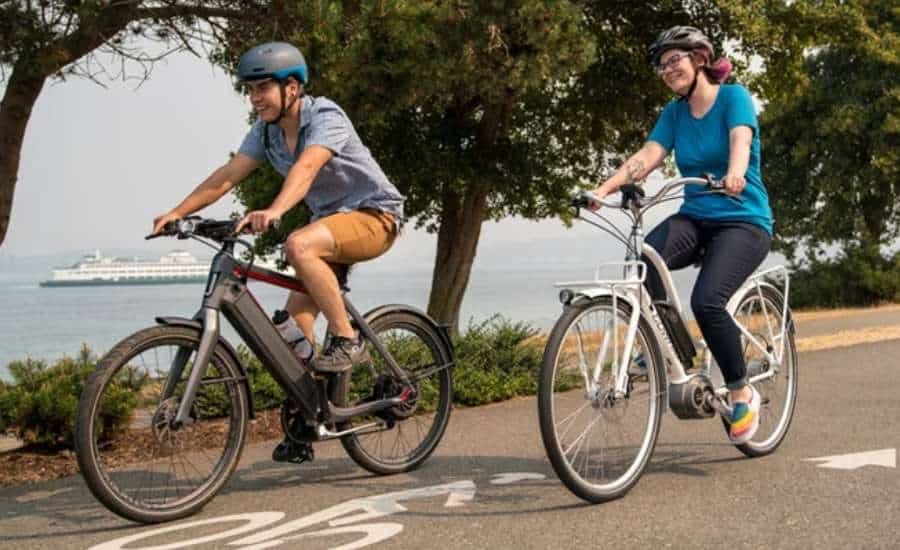Looking to hit the open road with an electric bike? One of the most important factors to consider when purchasing an ebike is weight. Not only will this impact your riding experience, but it can also affect how easy it is to transport and store your new ride.
In this article, we’ll discuss the different factors that contribute to the weight of an e-bike, such as the frame material, motor power, and battery capacity. We’ll also provide some tips on how to choose the right weight for your needs, based on your riding style, terrain, and physical abilities.
What’s the Average Weight of Different Types of Electric Bikes?

Generally speaking, the average weight of an electric bike can vary depending on its type and design. Here are some general weight ranges for different types of electric bikes:
🔲 Electric road bikes: Typically weigh between 25 to 35 pounds (11 to 16 kg).
🔲 Electric mountain bikes can weigh anywhere from 40 to 60 pounds (18 to 27 kg) due to their sturdy frames and heavy-duty components.
🔲 Electric folding bikes: These compact and portable options can weigh between 20 to 40 pounds (9 to 18 kg).
🔲 Electric cruiser bikes: These comfort e-bikes can weigh between 50 to 80 pounds (23 to 36 kg) due to their heavy frames and wide tires.
🔲 Electric cargo bikes: These bikes are designed to carry heavy loads weighing between 60 to 100 pounds (27 to 45 kg) or more, depending on their cargo capacity.
It’s also good to note that weight can vary with each type of electric bike, as some models may be lighter or heavier depending on their materials, components, and features.
Are Electric Bikes Heavier Than Regular Bikes?
In general, electric bikes are heavier than regular bikes. This is because they have a motor, battery, and other components that regular bikes do not have.
On average, an electric bike can weigh anywhere from 25 to 80 pounds (11 to 36 kg), while a regular bike typically weighs between 18 to 30 pounds (8 to 14 kg).
However, it’s important to note that the weight difference between electric and regular bikes can vary depending on the type and design of the bike.
For example, a regular heavy-duty bike designed for off-road use may weigh more than a lightweight electric road bike.
That said, many electric bike manufacturers have been working to reduce the weight of their bikes and make them more lightweight and portable while still providing the necessary power and performance for a comfortable and enjoyable ride.
Why Are E-bikes So Heavy?

Electric bikes, or e-bikes, are generally heavier than regular bikes for several reasons:
🔲 Motor: E-bikes have an electric motor that provides pedal assistance, which can add a significant amount of weight to the bike. The motor and associated components can weigh anywhere from a few pounds to over 10 pounds, depending on the size and power of the motor.
🔲 Battery: E-bikes require a battery to power the motor, and the battery can be a significant source of weight. Batteries can weigh anywhere from 3 to 10 pounds or more, depending on the size and capacity of the battery.
🔲 Frame: E-bikes often have a sturdier frame than regular bikes to support the weight of the motor and battery. The frame can be made of heavier materials like steel or aluminum, which can add to the bike’s weight.
🔲 Components: E-bikes may have other components that add weight, such as larger tires, suspension systems, and heavier brakes, to support the added weight and power of the motor and battery.
Despite their heavier weight, e-bikes offer several benefits over regular bikes, such as the ability to cover greater distances with less effort, climb hills with ease, and carry heavy loads.
Additionally, as technology continues to improve, e-bike manufacturers are working to make their bikes lighter without sacrificing performance or durability.
Factors That Affect the Weight of an Electric Bike
The weight of an electric bike can be affected by several factors, including:
🔲 Battery size: The battery is one of the heaviest components of an electric bike, so the size and capacity of the battery can have a significant impact on the weight of the bike.
🔲 Motor size and type: The motor is another heavy component on an electric bike. Larger motors or motors with more power can add more weight to an electric bike.
🔲 Frame material: The material used to construct the frame of the electric bike can also impact its weight. For example, steel frames are generally heavier than aluminum or carbon fiber frames.
🔲 Components: The weight of the components used on the bike can also affect its overall weight. For example, heavy-duty brakes or suspension systems can add weight to the bike.
🔲 Tire size: The size and type of tires used on the bike can also affect its weight. Wider tires, for example, can add weight to an e-bike.
🔲 Design: The overall design of the bike can also impact its weight. For example, an e-bike with a step-through frame may be heavier than one with a traditional frame due to the added reinforcement needed for the lower frame.
It’s important to consider these factors when selecting an electric bike, as they can impact the bike’s handling, maneuverability, and transportability.
Impact of Weight on Electric Bike Performance

The weight of an electric bike can have a significant impact on its performance. Here are a few ways in which weight can affect an electric bike:
🔲 Speed: A heavier bike can be more difficult to pedal and may not be able to achieve the same top speeds as a lighter bike. The added weight of an electric bike can also impact the speed at which it accelerates.
🔲 Range: The weight of an electric bike can affect its range or how far it can travel on a single charge. A heavy e-bike may require more power to maintain the same speed as a lighter e-bike, resulting in shorter range.
🔲 Handling: The weight of an electric bike can also impact its handling, especially when navigating turns or corners. A heavier bike can be more difficult to steer and require more maneuvering effort.
🔲 Climbing: The weight of an electric bike can affect its ability to climb hills. Heavy e-bikes will find it harder to power up and maintain speeds on very steep inclines as the gravitational pull on them is stronger than on lightweight models.
🔲 Transportability: The weight of an electric bike can also impact its transportability, especially if you need to transport the bike in a vehicle or carry it upstairs. A lighter bike can be easier to transport and maneuver than a heavy e-bike.
Does an Electric Bike’s Weight Affect Its Speed?
In most cases, an electric bike’s weight can affect its speed, especially when riding on flat terrain or trying to accelerate quickly. A heavier bike may require more power to maintain the same speed as a lighter bike, and the added weight can also slow down the bike’s acceleration.
This is because electric bikes use a motor and battery to provide pedal assistance, and the power required to move the bike increases with its weight. The motor has to work harder to move a heavier bike, and this can result in a lower top speed and slower acceleration.
However, it’s important to note that the impact of weight on speed will depend on several factors, including the power of the motor and the size and capacity of the battery. A more powerful motor and a larger battery can help compensate for the added weight of the bike, allowing it to maintain a higher speed.
The weight of an electric bike is just one of many factors that can affect its speed, and it’s important to consider other factors, such as the power of the motor, battery capacity, and the terrain, when evaluating the speed and performance of an electric bike.
Is a Lighter or Heavier E-bike Better?

Whether a lighter or heavier e-bike is better depends on your specific needs and preferences.
A lighter e-bike generally has the advantage of being more maneuverable and easier to handle.
It may also be more efficient and require less power, resulting in longer battery life and increased range.
On the other hand, a heavier e-bike can provide a more stable ride and may be better suited for certain types of terrain, such as steep hills or rough trails.
Additionally, a heavier e-bike may have a higher weight capacity and may be better able to carry heavier loads.
Ultimately, choosing between a lighter or heavier e-bike will depend on your intended use and personal preferences. It’s important to consider factors such as the terrain you’ll be riding on, how far you’ll be traveling, and how much weight you’ll need to carry.
FAQs
What is the average weight of an electric bike?
The average weight of an electric bike varies depending on factors such as the battery’s size, the motor’s power, and the materials used in construction. Generally, a standard e-bike can weigh between 40 lbs and 55 lbs (20 & 25 kg) including motor and battery.
Are electric bikes heavier than traditional bicycles?
Electric bikes are typically heavier than traditional bicycles due to the added weight of the battery and motor.
Does the weight of an electric bike affect its performance?
The weight of an electric bike can affect its performance, with lighter bikes generally being more efficient and easier to handle. In comparison, heavier bikes may provide a more stable ride and be better suited for certain types of riding conditions.

